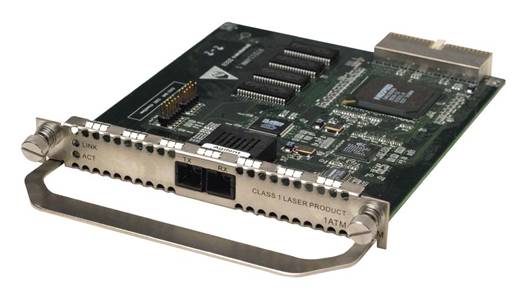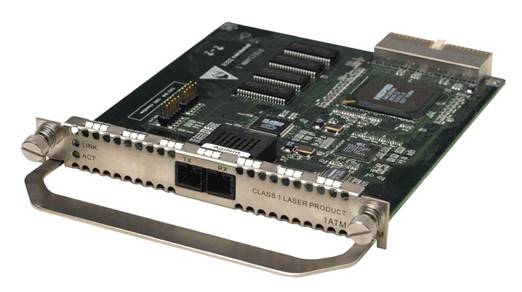ATM 155M Modules of H3C Series Routers
- 0关注
- 0收藏 660浏览
ATM 155M Modules of H3C Series Routers
I. Preface
ATM(Asynchronous Transfer Mode)technology, a backbone network technology, is designed to transmit voice, video and data information. It is considered one of core technologies enabling bandwidth communication for its flexibility and support for multimedia service.
ATM transmission mode is an asynchronous transfer mode on the basis of cell. Asynchronous indicated that the information cell flow from any users is not needed periodical. It is a special packet transmission technology, providing QOS guarantee and meeting the requirements of real-time services and non real time services.
ATM standard organization:
ITU-T: contribute to ATM standardization on public network. The representative standards include Q.2931/Q.2971, BISUP, I.610, and I.363 (1, 2, and 5).
ATM Forum: contribute to ATM standardization on private network and accelerate the popularization and use of ATM products. The representative standards include UNI3.1, UNI4.0, ILMI, PNNI, MPOA, VTOA, LANE, and TM4.0.
IETF: contribute to the standardization of bearing IP services on ATM network and resolve the bottleneck problem of traditional routers. The representative standards include:RFC1483, RFC1577, IP Switch, and MPLS.
II. Introduction
ATM 155M modules have three types: optical interface multimode, optical interface single-mode, optical interface single-mode long haul, working at 155M rate with full-duplex mode. The difference lies in the optical interface module.
1ATM-OC3MM 1-port 155M ATM multimode optical interface module
1ATM-OC3SM 1-port 155M ATM single-mode optical interface module
1ATM-OC3SML 1-port 155M ATM single-mode long haul optical interface module
ATM modules are primarily used to provide ATM interface for a router in system; the specified functions are as follows:
1. Support SDH STM-1 and SONET OC-3 two frame formats
2. Interference adding transmission is permitted when sending data
3. Support line clock (use when it functions as DTE interface) and internal clock (use when it functions as DCE interface) two clock modes
4. Support three self-loop test ways: internal cell self-loop, internal load self-loop, foreign echo
& Note:
Although full configuration is supported, Huawei-3Com recommends that only one ATM module is installed on various models of Quidway series modular routers. Installing several ATM modules will incur adverse effects on some mission-critical services.
III. Module Appearance
1ATM-OC3MM/1ATM-OC3SM/1ATM-OC3SML module appearance is shown as follows:
1ATM-OC3MM/1ATM-OC3SM/1ATM-OC3SML module appearance diagram
1ATM-OC3MM/1ATM-OC3SM/1ATM-OC3SML module panel is shown as follows:

1ATM-OC3MM module panel

1ATM-OC3SM module panel

1ATM-OC3SML module panel
The following table shows the implication of various indicators:
Implication of 1ATM-OC3MM/1ATM-OC3SM/1ATM-OC3SML module indicator
|
LINK |
Extinguished represents the link is not connected; lighting represents that the link is connected. |
|
ACT |
Extinguished represents no data has been received/sent; flashing represents some data has been received/sent. |
IV. Module Interface Fiber
1ATM-OC3MM module should connect multimode fibers and 1ATM-OC3SM/1ATM-OC3SML should connect single mode fibers. Three modules all employ SC type fiber connector, so it is required to connect fibers with SC type connectors. In terms of fiber length, user can select from external fiber suite as required.

SC type fiber connector appearance
& Note:
Fiber connector (also called as live connector): International Telecom Union (ITU) recommends to define it as “an inactive component used to stably but not permanently connect two or more fibers.” As the indispensable inactive component in optical communication system, the use of fiber connector makes it possible to enable a removable connection among optical channels.
There are a great deal of fiber connectors, for example:
(1) FC: cycle fiber connector with screw thread
(2) ST: cycle fiber connector with plug-in
(3) LC: square fiber connector
(4) MT-RJ: square transceiver fiber connector
l 1ATM-OC3SML module uses long haul optical interfaces. The transmission distance should not too short (larger than 25km), or you can not receive any data.
l 1ATM-OC3MM module should connect multimode fibers, 1ATM-OC3SM/1ATM-OC3SML should connect single mode fibers.
& Note:
The above three cables are optional cables. They are mandatory when user purchases 1ATM-OC3MM, 1ATM-OC3SM and 1ATM-OC3SML modules, or these cables will not available.
Connection of Module Interface Fiber
Attention:
The following proceedings should be noted when cabling fibers:
l Do not overbend fibers, its bend radius should no less than 10cm;
l Make sure that Tx side and RX side of module itnerface are connected correctly;
l Guarantee the cleanness of fiber surface.
Warning:
Laser danger! Do not directly observe fiber connectors attached to the laser diode, this may damage eyes.
Step 1: confirm Rx and Tx optical interfaces on the module, and insert one side of a fiber into Rx interface of 1MFX/1SFX module, the other is attached to Tx interface of the peer; insert one side of another fiber into Tx interface of 1MFX/1SFX module, the other is attached to Rx interface of the peer.
Step 2: after powered on, examine the indicators of the corresponding slots on the front panel of router. Lighting represents that self test of the module has been accomplished and the module can work well; extinguished represents that self test did not pass after the module inserted, please contact the agent.
Step 3: examine the LINK indicator state of 1ATM module panel. Lighting represents that Rx link is connected; extinguished represents that Rx link is not connected, please examine lines.
& Note:
The fibers are divided into two types: multimode fiber and single mode fiber by optical transmission mode:
l The core of single mode fiber is small, so it is only transmitted in single mode on given wavelength, with wide transmission band and large transmission capacity.
l Multimode fiber refers to a fiber transmitted in multimode on given wavelength. For multimode transmission, since the optical transmitting rate varies among different modes, this will cause phase difference and thus transmission distortion, limiting its transmission band. The multimode optical includes 62.5m (fiber core size) and 50m two systems. Both are acceptable transmission medias in ISO/IEC 11801 standard.
Configuration of Module Interface Fiber
1ATM-OC3MM module can employ total of three fibers (the difference lies in length):
1 14130141 fiber connector-SC/PC-SC/PC-multimode -3mm-2m number is optional
2 14130156 fiber connector-SC/PC-SC/PC- multimode -3mm-5m number is optional
3 14130127 fiber connector-SC/PC-SC/PC- multimode -3mm-15m number is optional
Each 1ATM-OC3MM module comes with two receiving/sending ports, so fibers must be selected in pairs, i.e. each module should select two fibers.
1ATM-OC3SM and 1ATM-OC3SML modules can employ total of three fibers (the difference lies in length):
1 14130176 fiber connector-SC/PC-SC/PC-single mode-3mm-2m number is optional
2 14130098 fiber connector-SC/PC-SC/PC- single mode -3mm-5m number is optional
3 14130126 fiber connector-SC/PC-SC/PC- single mode -3mm-15m number is optional
Each 1ATM-OC3SM and 1ATM-OC3SML modules come with two receiving/sending ports, so fibers must be selected in pairs, i.e. each module should select two fibers.
V. Module Interface Attributes
1ATM-OC3MM/1ATM-OC3SM/1ATM-OC3SML module interface attributes
|
Attributes |
1ATM-OC3MM module |
1ATM-OC3SM module |
1ATM-OC3SML module |
|
Type of fiber connector |
SC | ||
|
Connector number |
1 | ||
|
Interface standard |
SONET OC-3/SDH STM-1 | ||
|
Interface rate |
155Mbps | ||
|
Type of cable and maximum transmission |
Multimode optical (transmission distance 2km) |
Single mode optical (transmission distance 15km) |
Single mode optical (transmission distance 30km) |
|
Type of transmitter |
LD |
LED |
LD |
|
Transmitting optical power |
Minimum: -19dBm Maximum: -14dBm |
Minimum: -15dBm Maximum: -8dBm |
Minimum: -5dBm Maximum: 0dBm |
|
Receiving sensitivity |
Minimum: -28dBm Maximum : -8dBm |
Minimum: -30dBm Maximum :-14dBm |
Minimum: -34dBm Maximum :-10dBm |
|
Core wavelength |
1310nm | ||
|
Service |
Supports ATM Traffic CBR (Constant Bit Rate), rt_VBR (Variable Bit Rate-Real Time), nrt_VBR (Variable Bit Rate-Non Real Time), UBR (Unspecified Bit Rate) | ||
该案例暂时没有网友评论
编辑评论
✖
案例意见反馈


亲~登录后才可以操作哦!
确定你的邮箱还未认证,请认证邮箱或绑定手机后进行当前操作
